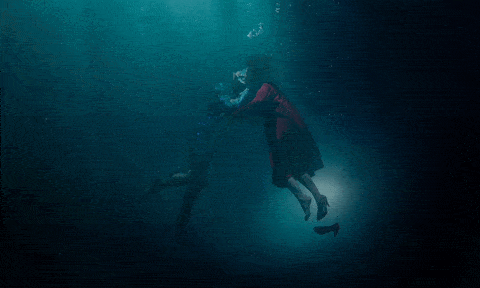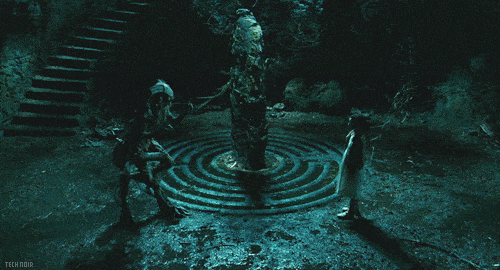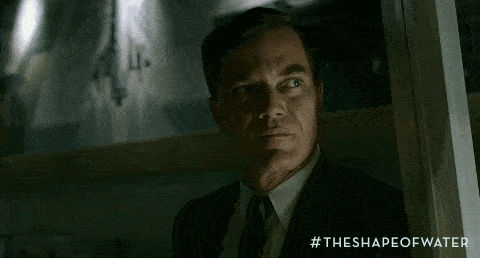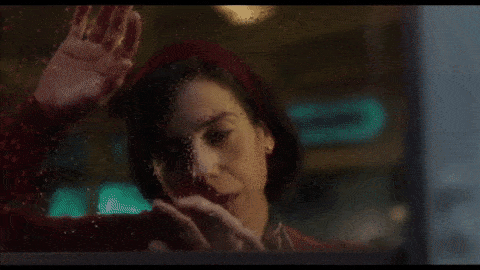When The Shape of Water ended, I was excited for a few reasons. First, I’m a sap and the happy ending made me happy. Second, the ending was mysterious enough that I knew I’d be writing about it. Third, I recognized that the ending had a lot in common with Pan’s Labyrinth.


The Shape of Water is Happy Pan’s Labyrinth
In Pan’s Labyrinth we have a frame narrative of a young princess from the Underworld getting lost in the mortal world. We’re told her spirit may reincarnate and the king hopes to guide it back home. Then we meet Ofelia.
Is Ofelia the reincarnated Princess Moanna? The movie is a brutal dance between reality and fantasy. We’re never sure if the fantastic elements Ofelia encounters are signs of her spiritual destiny or the fanciful escapes of a young girl overwhelmed by the harshness of the world. When she dies, we’re left wondering if we should be happy or not. That’s one of the sadly beautiful aspects of Pan’s Labyrinth.
The Shape of Water gives us Elisa. We’re told she’s an orphan who was found as a baby in a basket in the water. We’re told she had suffered injuries that ruined her vocal chords. And we can see the scars: three slash marks on each side of her neck.
At the end of the movie, the god-like creature slides his hands along Elisa’s neck. Her scars open, revealing gills. Now she can breathe underwater! We’re told by the voice over from Giles that the two escaped together. How great!
Elisa’s vague backstory begs the question: could del Toro be exploring the Princess Moanna/Ofelia dynamic a second time? He would be far from the first writer to examine a concept across multiple works. Look at Fincher with the psychological affects of a criminal investigation: Seven, Zodiac, Girl with the Dragon Tattoo. Or Spielberg and parenthood: Hook, Jurassic Park, Minority Report, War of the Worlds.
The major difference with Shape of Water is that we aren’t explicitly told the “Princess Moana” part of things. Instead, it’s disguised. It’s subtext that one has to engage with rather than context that’s given to the audience. This allows those who want to simply enjoy the story as-is to enjoy the story as-is. But it means that those who want to dig deeper have some nuance to sink their teeth into.
With that in mind, just read the opening narration again:
“If I spoke about it…if I did…what would I tell you? I wonder? Would I tell you about the time? It happened a long time ago, it seems, in the last days of a fair prince’s reign. Or would I tell you about the place? A small city near the coast but far from everything else. Or…I don’t know…would I tell you about her? The princess without voice. Or perhaps I would just warn you, about the truth of these facts and the tale of love and loss, and the monster who tried to destroy it all.”
It’s hard to hear this opening speech and not recall the Princess Moanna story. Especially in light of what we know of Elisa’s backstory. And then all the other similarities between the movies.
Some similarities
Instead of a young girl, del Toro gives us an adult woman.
Instead of a tragedy, we get romance.
Instead of us questioning a little girl’s sanity and the things she sees, this time we know the creature exists.
Both movies provide antagonists who are cruel, cold military men who are dominant and particular and particularly violent.
One antagonist never gets the on-screen comeuppance we wish he would. The other does.
Instead of the Spanish Civil War as a macro situation, we have the American-Russian Cold War.
Both have doctors who are spies and who are shot and killed.


Both Ofelia and Elisa have caretakers who are there for them when they “die”.
One ends with the protagonist dying but maybe not dying. The other ends with the protagonist not dying but maybe dying.
Wait, did you say Elisa might be dead?
Yeaaaaahhhhhh, that’s a thing. And it’s a subtle thing.
What’s the first thing we see in the movie? An apartment underwater. And we see a “sleeping” Elisa floating in the water. Keep in mind, the opening speech closes with: “Or perhaps I would just warn you, about the truth of these facts and the tale of love and loss, and the monster who tried to destroy it all.”
Then the closing narration:
“If I told you about her, what would I say? That they lived happily ever after? I believe they did. That they were in love? That they remained in love? I’m sure that’s true. But when I think of her, of Elisa, the only thing that comes to mind is a poem, whispered by someone in love hundreds of years ago. ‘Unable to perceive the shape of you, I find you all around me. Your presence fills my eyes with your love. It humbles my heart. For you are everywhere.'”
Giles doesn’t know Elisa’s fate. And he’s the one telling us this story. It could be that he, the hopeless romantic that we know he is, has simply imagined Elisa’s happily ever after. That he’s convinced the creature had the power to save her. That’s why her body was never found. But he doesn’t know. This could still be a tale of “love and loss”. And while the poem could be about Elisa and the creature, it could very well be Gile’s feelings about Elisa. He did love her, as a friend. And now he is unable to perceive the shape of her, imagining she’s something greater now. A princess to a prince. A goddess to a god. So he feels her all around him.
Given how many similarities there are between Pan’s Labyrinth and Shape of Water, it would be a surprising if the conclusion were simply one-dimensional. And while it’s not as blatant as it is in Pan’s Labyrinth, the ingredients are still there for this to have been a tragedy. Similar in the way that the ingredients are still there for Pan’s Labyrinth to have a happy ending. But where one skews strongly tragic, the other skews strongly romantic.
So…is she dead or not?

I think it’s safe to say that del Toro wanted to make a romance, not a tragedy. So I’d argue the implication is that Elisa lives, just like it’s strongly implied that Ofelia is actually dead. Elisa’s story is the other side of the coin to Ofelia. Poor Ofelia. But yay for Elisa!

